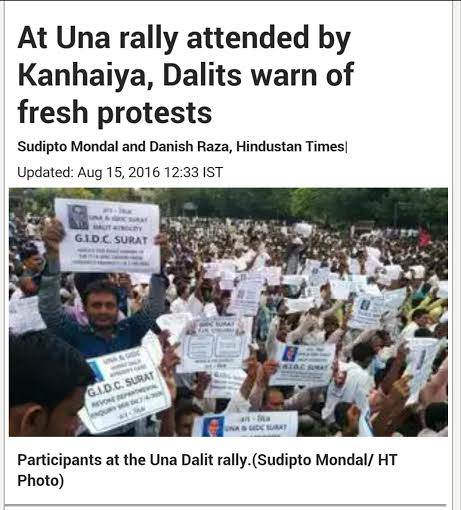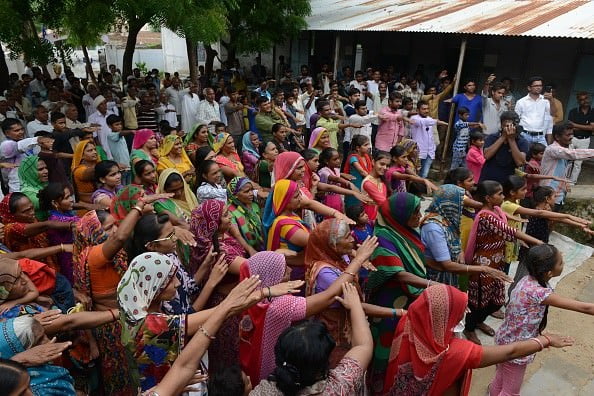On 5th August 2016, the 10 day long Dalit Asmita Yatra commenced from Ahmedabad after four Dalit men were brutally beaten by Gau Rakshaks, charging beef consumption and skinning of a dead cow. Following this, huge unrest erupted among the Dalit community and the Una Dalit Attyachar Ladat Samiti was formed to fight against this callous atrocity and demand justice. On 31st July, the Dalit Mahasammelan saw the coming together of over 20,000 Dalits at Ahmedabad, leading to the Dalit Asmita Yatra.
There was a complete black out of the uprising initially in the mainstream media. It was only later and during the past few days that the Yatra saw some coverage by the mainstream media. What one needs to look at is not just the fact that the mainstream media ducked reporting the Dalit uprising prior to this, but also that the existing coverage had a very prejudiced tone to it.
For starters, Huffington Post published a report with names of upper caste men as leaders of the Una march. Sanghapali Aruna Lohitakshi’s interview on The Ladies Finger explains what it was like to actually be at the rally. Many leaders on the stage did not even wait for Radhika Vemula’s speech to finish, she tells in the interview. An article on Hindustan Times did not talk about the demand for land by the Dalits while calling the Yatra a success. Further, they thought it would make more sense to mention Kanhaiya Kumar in its headlines to talk about the strength of the Yatra. The Indian Express stated false numbers saying ‘some 6000 odd Dalits had gathered at Una on 15th August’. Makes one wonder why Kanhaiya’s name appears in the headlines when he was not even a part of the struggle, let alone someone who was affected by the atrocities that happened.

Hindustan Times
If this wasn’t enough, look how Hindustan Times spoke about Radhika Vemula as someone who was ‘also’ just merely present at the rally. A closer look at the savarna mainstream media also brings to light the triviality with which Dalit women leaders were reported in the context of the Dalit Asmita Yatra. As Sanghapali points out,
“Manisha Mashaal tried to step up to the mic, but one of the men on the stage actually grabbed her hand and tried to pull her back. She had to physically pull herself free to be able to go up and speak.”
So think about this – Who is present despite being absent and who is absent despite being present at this historic moment in the Dalit struggle? Why do we need to interrogate this hijacking of the Dalit struggle by the dominant upper caste savarna media?

“Hey news outlets #Dalit women lead not only women but all Dalit People! Please follow Manjula Pradeep, Manisha Mashaal, Rajni Mishal for #Dalit women’s perspectives at #ChaloUna Manjula Pradeep can also connect you to many voices so please stop erasing all of our leaders! #Dalitwomenfight” -Thenmozhi Soundararajan
The mainstream media has always had its vested interests align with the dominant caste and class of this country. But why is it so significant in the context of the Una struggle? Kuffir Nalgundwar, founder-editor of Round Table India spoke to FII, “The media is just following its regular course – they can’t change their caste-class perspective. They have to be faithful to their interests.” He went on to add, “For instance, they (the media) are owned by, and cater to a readership that owns most of the land in Gujarat. If the Dalits want their share of land, which is also tied to dignity in the rural landscape, can we expect the media to reform its caste-class character overnight and stand by the Dalits because it is a just cause? Justice to the media would mean something entirely different. It would mean the maintenance of the status quo.”
The demands made by the Dalits, i.e. to give up the traditional caste based occupations of skinning or disposing cattle and cleaning sewer lines, and get 5 acres of land, disturb exactly this – the status quo of the dominant. While the mainstream media is trying to box the Dalit struggle as a struggle of gaining mere recognition, one must understand that it is much more than that. It is about reorganisation and redistribution of power and resources, along with the demand for dignity – everything that the marginalized people have been denied.
Dhrubo Jyoti, a journalist based in New Delhi rightly points out in an article on Round Table India how the UP elections became the point of discussion in almost all the mainstream reports, instead of actually dwelling on the significance of the protest. Quoting Dhrubo, “Most of these savarna-dominated newsrooms have highly qualified, highly educated journalists who are liberal, believe in free speech and say they don’t believe in caste but falter with anti-caste coverage. This cannot change until newsrooms have hundreds of Dalit, Bahujan and Adivasi journalists.”
This is why the Dalit struggle needs to be seen from the perspective of the Dalits. As opposed to the mainstream media, the coverage of the Dalit uprising by spaces like Round Table India and platforms like Dalit Camera: Through Un-touchable Eyes bring their own voices at the centre of the struggle. The Dalit Camera has been constantly reporting, uploading videos, giving live updates about the Una March to ensure that right voices are heard. A look at their videos tell us that these voices are spread across a pool of supporters who were marching to Una.
On speaking with FII, Dalit Camera told us how there was lack of electronic media during the course of the rally, and only CNN-IBN was seen doing a small video clip. There were no live coverage vans as well. They also told us,
“The bias is obviously due to the lack of proportional representation of Dalits in media or rather highly disproportionate representation of dominant castes, especially Brahmins in national media. They serve to protect their own social location and their caste interests, which explains their overt coverage of Modi, who is a failure as a PM at many levels; and blackout of such a massive protest by Dalits in a highly conservative Sangh-Parivar dominated state, Gujarat.”
Also talking about the vested interests of the right wing media, they added, “The Yatra itself is a huge success of Dalit anti-caste assertion against Brahmanism. The media missed reporting on a very important historical movement, which is very much necessary in these violent times created by the RSS Brahmin dominated BJP. This shows whose interests the so called liberal English speaking caste-Hindu media serves to protect.” They rightly point out what needs to be at the centre stage – the forging of new alliances between Dalits and Muslims, the solidification of anti-caste Ambedkarite politics to annihilation of caste, and the participation of the youth in the movement.
The mainstream media will have us all believe that this, like many other protests, is a ‘temporary’ wave. They will call it a political strategy controlled by some political leaders making fool out the ‘victimized poor Dalits’ – the rhetoric our mainstream media loves so much! They will make their own interpretations, without listening to what the Dalits, the thousands who participated, are saying. They will subjugate the Ambedkarite Dalit assertion by ignoring the fact that this is not just about saying ‘NO’, but about deconstructing and restructuring the whole idea of what secularism and equality means.
This compels us to look at the spaces that Dalit groups, supporters and individuals have created as their new media spaces that talk not just about their lived realities, but also acknowledge the struggles of their existence and their experiences. The knowledge that gets produced by mainstream media is challenged by these new spaces where they openly question the language of support, solidarity, politics of co-option, and the status quo of dominant groups. This has been largely missing from our mainstream stories.
The assertion of Dalit groups by ways of creating new media spaces challenges how mainstream media talks about caste and makes them reflect on their social location and power positions. And most importantly, it is not about showing a different fragmented perspective of the Dalit community, rather it is about critiquing the entire discourse around secularism, development, nationalism, and modernity; and about asserting that it is the Dalit movement that changes the mainstream discourse and not the other way round.
About the author(s)
Nupur is a graduate in Women’s Studies. Interests include research, academia, gender, sexuality and politics.




